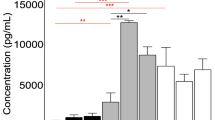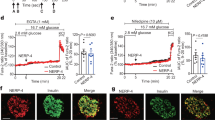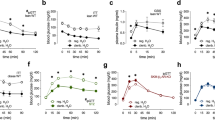Abstract
Insulin resistance occurs in a variety of conditions, including diabetes, obesity and essential hypertension1, but its underlying molecular mechanisms are unclear. In type 2 (non-insulin-dependent) diabetes mellitus, it is insulin-resistance in skeletal muscle, the chief site of insulin-mediated glucose disposal in humans2, that predominantly accounts for the low rates of glucose clearance from the blood, and hence for impaired glucose tolerance3. Human type 2 diabetes is characterized by a decrease in non-oxidative glucose storage (muscle glycogen synthesis)4,5, and by the deposition of amyloid in the islets of Langerhans6,7. Amylin is a 37-amino-acid peptide which is a major component of islet amyloid and has structural similarity to human calcitonin gene-related peptide-2 (CGRP-2; ref.8). CGRP is a neuropeptide which may be involved in motor activity in skeletal muscle9,10. We now report that human pancreatic amylin and rat CGRP-1 are potent inhibitors of both basal and insulin-stimulated rates of glycogen synthesis in stripped rat soleus muscle in vitro. These results may provide a basis for a new understanding of the molecular mechanisms that cause insulin resistance in skeletal muscle.
This is a preview of subscription content, access via your institution
Access options
Subscribe to this journal
Receive 51 print issues and online access
$199.00 per year
only $3.90 per issue
Buy this article
- Purchase on Springer Link
- Instant access to full article PDF
Prices may be subject to local taxes which are calculated during checkout
Similar content being viewed by others
References
Ferrannini, E. et al. New Engl. J. Med. 317, 350–357 (1987).
DeFronzo, R. A. & Ferrannini, E. Diabetes/ Metabolism Rev. 3, 415–459 (1987).
Kolterman, O. G. Diabetes/ Metabolism Rev. 3, 399–414 (1987).
Bogardus, C., Lillioja, S., Stone, K. & Mott, D. J. clin. Invest. 73, 1185–1190 (1984).
Meyer, H. U., Curchod, B., Maeder, E., Pahud, P. & Jequier, E. Diabetes 29, 752–756 (1980).
Opie, E. L. J. exp. Med. 5, 397–428 (1900).
Bell, E. T. Diabetes 1, 341–344 (1952).
Cooper, G.J.S. et al. Proc. natn. Acad. Sci. U.S.A. 84, 8628–8632 (1987).
Mason, R. T. et al. Nature 308, 653–655 (1984).
Takami, K. et al. Neurosci. Lett. 60, 227–230 (1985).
Rennie, M. J. & Edwards, R. H. T. Carbohydrate Metabolism and its Disorders Vol. 3. (eds Randle, P. J., Steiner, D. F. & Whelan, W. J.) 1–121 (Academic, London, 1981).
Foulkes, J. G., Gehen, P., Strada, S. J., Everson, W. J. & Jefferson, L. S. J. biol. Chem. 257, 12493–12496 (1982).
Challiss, R. A. J., Leighton, B., Lozeman, F. J. & Newsholme, E. A. in Topics and Perspectives in Adenosine Research (eds Gerlach, E. & Becker, B. F.) 275–285 (Springer, Berlin, 1987).
Foord, S. M. & Craig, R. K. Biochem. Soc. Trans. 15, 714–716 (1987).
Tschoop, F. A. et al. Proc. natn. Acad. Sci. U.S.A. 82, 248–252 (1985).
Seifert, H. et al. Am. J. Physiol. 249, G147–G151 (1985).
Leighton, B., Kowalchuk, J. M., Challiss, R. A. J. & Newsholme, E. A. Am. J. Physiol. 255, E41–E45 (1988).
Wajngot, A., Roovete, A., Vranic, M., Luft, R. & Efendic, S. Proc. natn. Acad. Sci. U.S.A. 79, 4432–4436 (1982).
Yki-Jarvinen, H., Mott, D., Young, A. A., Stone, K. & Bogardus, C. J. clin. Invest. 80, 95–100 (1987).
Young, A. A., Bogardus, C., Wolfe-Lopez, D. & Mott, D. M. Diabetes 37, 303–308 (1988).
Hewick, R. M., Hunkapiller, M. W., Hood, L. E. & Dreyer, W. J. J. bio. chem. 256, 7990–7997 (1981).
Heinrikson, R. L. & Meredith, S. C. Analyt. Biochem. 136, 65–74 (1984).
Ishizuka, J., Greely, G. H., Cooper, C. W. & Thompson, J. C., Regul. Peptides 20, 73–82 (1988).
Leighton, B., Challiss, R. A. J., Lozeman, F. J. & Newsholme, E. A. Biochem. J. 20, 551–554 (1988).
Leighton, B. et al. Int. J. Biochem. 20, 23–27 (1988).
James, D. E., Jenkins, A. B. & Kraegen, E. W. Am. J. Physiol. 248, E567–E574 (1985).
Author information
Authors and Affiliations
Rights and permissions
About this article
Cite this article
Leighton, B., Cooper, G. Pancreatic amylin and calcitonin gene-related peptide cause resistance to insulin in skeletal muscle in vitro. Nature 335, 632–635 (1988). https://doi.org/10.1038/335632a0
Received:
Accepted:
Issue Date:
DOI: https://doi.org/10.1038/335632a0
This article is cited by
-
Alterations in metabolic flux in migraine and the translational relevance
The Journal of Headache and Pain (2022)
-
Altered metabolic gene expression in the brain of a triprolyl-human amylin transgenic mouse model of type 2 diabetes
Scientific Reports (2019)
-
An Intraperitoneal Treatment with Calcitonin Gene-Related Peptide (CGRP) Regulates Appetite, Energy Intake/Expenditure, and Metabolism
Journal of Molecular Neuroscience (2019)
-
Serum calcitonin gene-related peptide facilitates adipose tissue lipolysis during exercise via PIPLC/IP3 pathways
Endocrine (2018)
-
Role of calcitonin gene-related peptide in energy metabolism
Endocrine (2017)
Comments
By submitting a comment you agree to abide by our Terms and Community Guidelines. If you find something abusive or that does not comply with our terms or guidelines please flag it as inappropriate.



